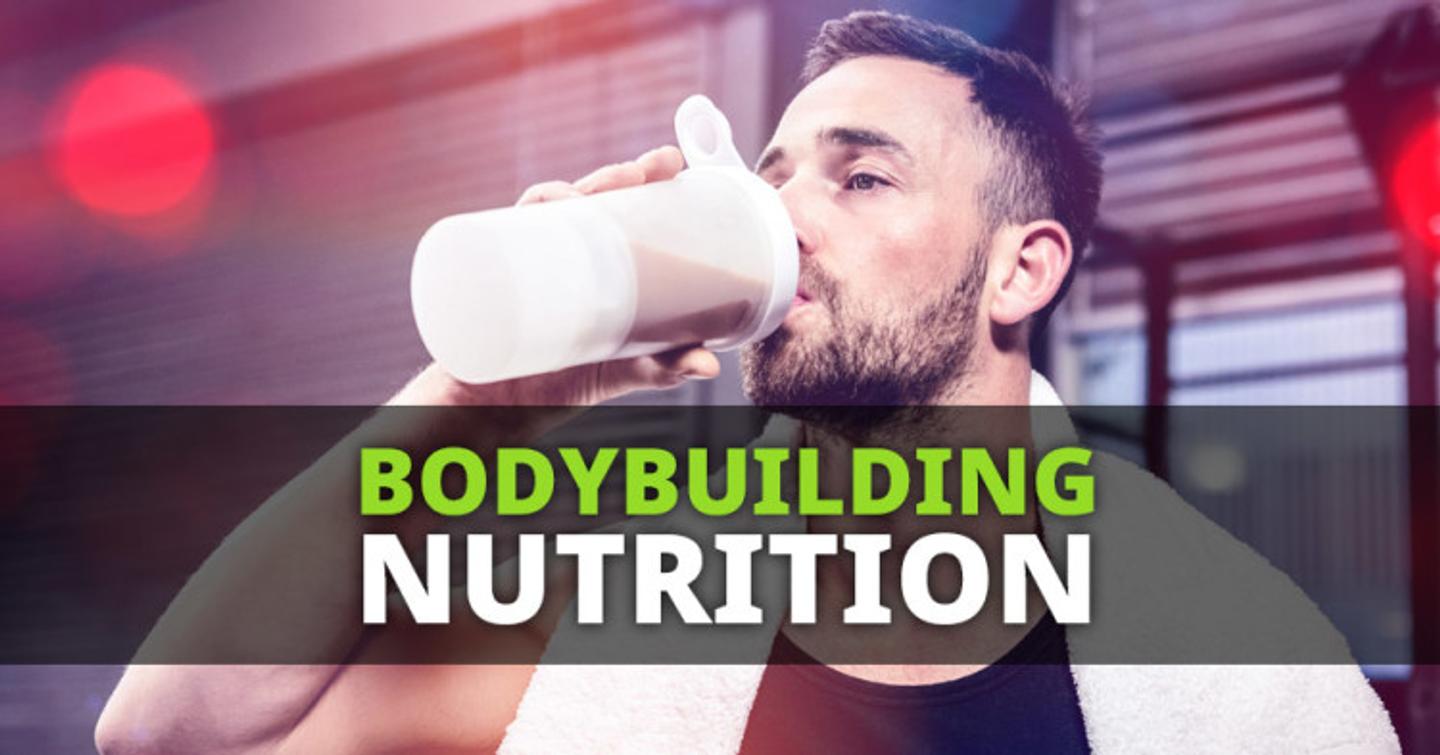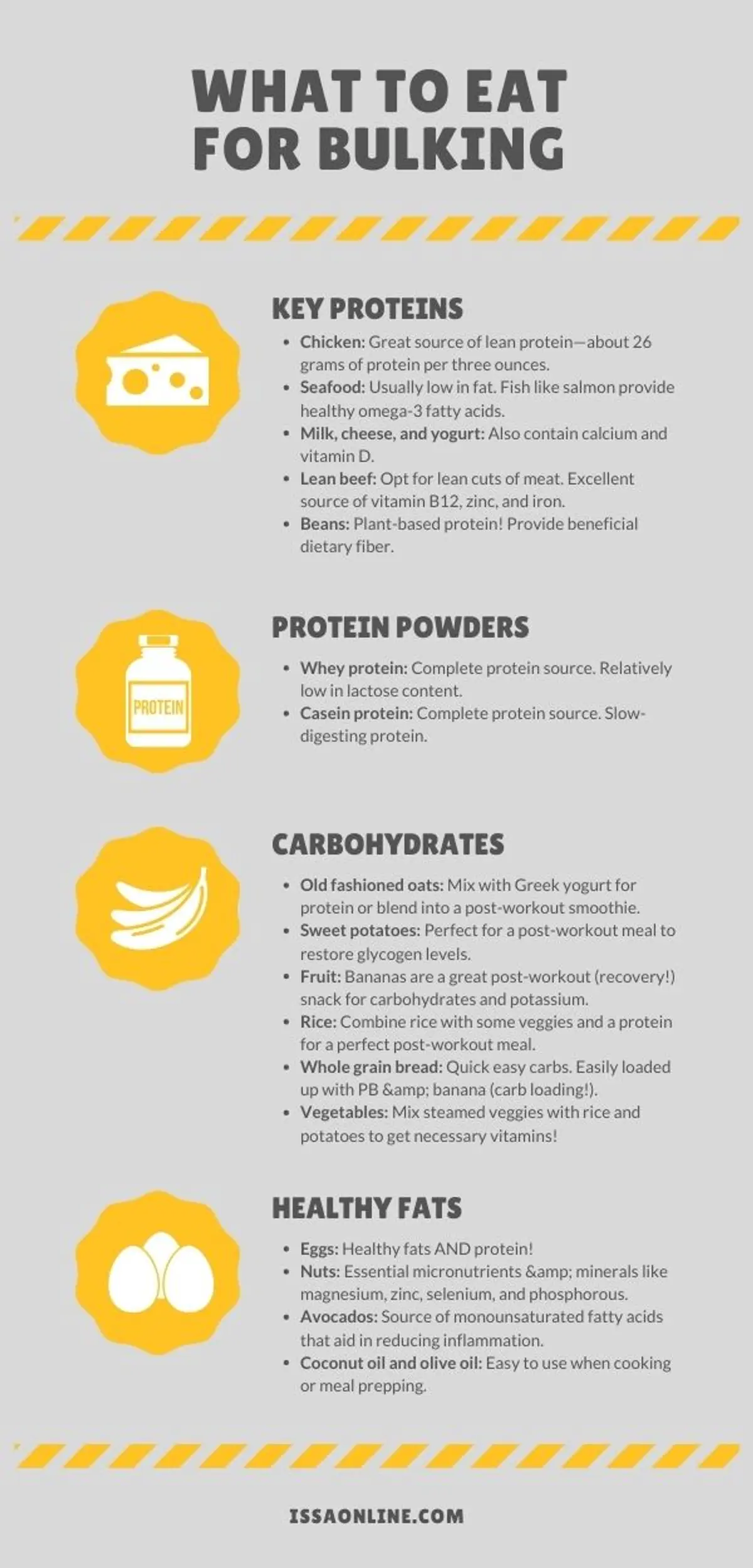
Bodybuilding Nutrition: What to Eat for Bulking
Reading Time: 6 minutes 53 seconds
BY: ISSA
DATE: 2022-04-07
Many athletes are looking to get on board with the “bulking” trend. Bulking involves gaining weight and overall muscle mass to support strength development. Most athletes interested in bulking understand the time it will take in the gym to achieve results. Yet, just as important is time outside the gym. Nutrition plays a key part in your clients’ bulking success.
Nutrition for bulking in simplest terms involves eating more calories than you expend. This keeps your body in a positive caloric balance. When the body is in a positive caloric balance it enters an anabolic growth state.

Download this FREE infographic here!
How Many Calories Are Enough Calories?
The easy part is understanding that you need to eat more calories than you burn, a calorie surplus. The hard part is knowing exactly how many calories that is. Unfortunately, it is not a cut and dry answer. Everyone’s body is unique. This lends to difficulty in standardizing the exact number of calories needed when bulking. Daily caloric needs depend upon several factors including age, gender, body weight, activity level, and genetics just to name a few.
Eating too few calories when training for bulking is one of the biggest mistakes your clients can make. Bulking does not lead to well-defined abs. Bulking leads to gaining weight and packing on extra mass to build overall strength. You will need to be in a calorie surplus to gain mass, but the amount will vary drastically from person to person considering weight and nutrition history along with training regimen.
When focusing on gaining muscle, Trifecta Registered Dietitian and board-certified sports nutritionist Emmie Satramzemis comments, “Any weight gain in a calorie surplus will involve some amount of muscle and some increases in body fat. The key is to tip the odds in favor of more muscle mass than fat. This results in better body composition and fitness outcomes.”
Formulas to calculate your client’s total daily energy expenditure (TDEE) can be helpful. TDEE is a measure of the calories required per day to support normal function. You can then add on extra calories from here to promote bulking. Such a formula can be useful to recalculate your clients’ weight as it changes during their bulking phase.
Macronutrient Breakdown
The most important part of bulking is getting your clients eating more calories. But just as important is what these calories consist of. What exactly should your clients’ high-calorie diet look like to help them gain weight and lean muscle in a healthy manner?
The body requires three macronutrients: carbohydrate, protein, and fat. Determining the necessary macronutrient ratios is critical when bulking. Higher carbohydrate, moderate protein, and lower fat ratios have been shown to promote bodybuilding and muscle growth.
Recommended percentages of total caloric intake:
40-60% carbohydrate
25-35% protein
15-25% fat
Carbohydrates
Carbohydrates supply a necessary energy source during training. When we consume carbohydrates, they are broken down and used to replenish glycogen stores within the muscle. When the muscles perform work, they rely on these glycogen stores to develop and create energy to perform the task at hand. Consuming adequate carbohydrates prior to training reduces glycogen depletion.
Trifecta Dietitian Mikayla Jorgensen states, "Carbohydrates are especially important for athletic performance because of their ability to be used as quick, readily available fuel for our bodies and brain. This ability is key for optimal performance and recovery in high endurance and explosive training."
Failure to consume adequate carbohydrates may impair strength training and muscle development.
Protein
Protein supplies the building blocks in recovery and repair to form new muscle. Protein is made up of amino acids. These are often referred to as the building blocks of proteins. Amino acids play many important roles within the body. They are most importantly needed for growth and repair. Your body needs 20 different amino acids to function and grow properly. Although all 20 are important for overall health, nine amino acids are classified as essential. Essential means that they cannot be made by your body. Essential amino acids must be consumed through your diet.
Amino acids are composed of nitrogen. When you consume adequate protein your body experiences a positive nitrogen balance. This balance is the body’s total pool of protein available for use. A positive balance signals the body into an anabolic muscle-building state. Failure to consume enough protein will not signal this anabolic state. If your clients are not consuming enough protein, the body will use the protein available to simply maintain rather than build muscle. Encourage your clients to consume adequate protein to support new muscle growth.
Fat
Fats can also supply energy to the body and support cell growth. Unsaturated fat is known as “healthy fat.” Saturated fat is slightly better than trans fat, but clients still don’t want to include too much of either in their diet. In general, suggest clients try to keep trans fat out of their diet—especially the type found in processed foods.
An easy way to incorporate healthy fats into your diet is by using olive oil in your cooking method or sauces.
Healthy fat consumption should never fall below 15% of total calories. Hormones are constructed from cholesterol and fat molecules. Consuming inadequate amounts of healthy fats can suppress normal hormone levels. Hormones are responsible for bodily functions such as growth and development. Irregularity in hormone levels can negatively affect your clients’ attempts at bulking. Be sure your clients are incorporating healthy fats into their diet.
Nutrition for Bulking
Calorie intake is dialed in. Macros are set. Now it’s time to discuss what foods your clients should be eating to hit their bulking goals.
There are healthy and unhealthy ways to approach bulking. There’s a big difference in filling up on nutritious homemade meals (clean bulk) or eating junk food all day to hit your macros (dirty bulk). Dirty bulking likely leads to more fat gain than muscle gain. The best and healthiest option for your client is to eat for clean bulking. The following food options support a healthy clean bulking diet.
Key Proteins for Bulking
Chicken: A chicken breast is a great source of lean protein. It provides about 26 grams of protein per three ounces.
Seafood: Seafood is a good source of protein as it is usually low in fat. Fish like salmon are a little higher in fat but provide healthy omega-3 fatty acids.
Milk, cheese, and yogurt: Dairy foods are great sources of protein. In addition, they contain calcium and vitamin D. Greek yogurt and cottage cheese are great high protein snacks. They can be eaten alone, mixed with berries or mixed into a smoothie to add some extra protein.
Lean beef: Beef has more fat in comparison to white poultry meat such as chicken. Encourage your clients to opt for lean cuts of meat. Beef also serves as an excellent source of vitamin B12, zinc, and iron.
Beans: These can serve as a great alternative to animal protein. Unlike animal protein, beans provide beneficial dietary fiber. Check out this ISSA post on plant-based protein options to help guide your vegetarian and vegan clients.
Protein Powders
Supplementing with protein powder can be an easy way to get more protein into your clients’ diet. Two healthy options are whey protein and casein protein.
Whey protein: Whey is a complete protein source. This means it has all nine essential amino acids. It is relatively low in lactose content so can be ideal for those with lactose sensitivities. Whey protein supplementation coupled with resistance training has been shown to improve muscle synthesis and promote muscle tissue growth.
Casein protein: Casein is also a complete protein providing all nine essential amino acids. This slow-digesting protein releases amino acids slowly, so it can help you feel full longer. It may be of benefit for your clients to consume casein before bed to aid with recovery and reduce muscle breakdown while sleeping.
Carbohydrates
Old fashioned oats: Oats are a terrific way to get carbohydrates, fiber, and extra calories into your diet. They can be enjoyed in the morning for breakfast mixed with some Greek yogurt for protein or blended into an afternoon post-workout smoothie.
Sweet potatoes: These are a great carbohydrate source full of nutrients and fiber. They are perfect for a post-workout meal to restore glycogen levels.
Fruit: It comes in all shapes and sizes and can offer variety to your clients’ diet. Fruit also offers essential nutrients and antioxidants. These are great for protecting against cell damage. Bananas are a great post-workout snack as they offer carbohydrates as well as potassium to aid in recovery. Encourage your clients to eat fresh fruit over dried fruit. Dried fruit is usually loaded with added sugars. The natural sugars from fruit will better support your clients’ bulking goals.
Rice: White rice has been arguably considered one of the best foods for adding muscle. It provides a high volume of carbohydrates per serving and is an easy filler. Combine rice with some veggies and protein for a perfect post-workout meal.
Whole grain bread: Bread has gotten a bad rap lately. Especially with the recent explosion in low carbohydrate diets. But if your clients’ goals are to bulk and build muscle mass, the last thing they want is a low carbohydrate diet. Bread is a great way to get quick easy carbs in and can easily be loaded up with some peanut butter and sliced banana for even more carb loading.
Vegetables: Veggies supply a great source of complex carbohydrates. They vary in the amount of carbohydrates they provide depending on if they are starchy or non-starchy vegetables, but they are essential to maintain overall health during your clients’ bulking season. Vegetables are packed full of necessary vitamins and nutrients. The vitamins and minerals found in vegetables aid in supporting growth and repair. Have your clients mix in some steamed veggies with their rice and potatoes to get those necessary vitamins in.
Healthy Fats
Eggs: These are a great source of healthy fats. In addition, they double as a healthy source of protein as well. They are a great breakfast option served alongside some oatmeal and fresh fruit.
Nuts: An energy- and nutrient-dense food, nuts have healthy monounsaturated fats. Nuts and nut butters are packed full of essential micronutrients and minerals like magnesium, zinc, selenium and phosphorous. These micronutrients and minerals are essential in maintaining a healthy nutritional status to support building muscle mass.
Avocados: A reliable source of monounsaturated fatty acids. These fatty acids help aid in reducing inflammation. In addition, avocados provide a high number of antioxidants and vitamin E which support cardiovascular health.
Olive oil: A great way to add healthy fats into your diet. Encourage your clients to make small changes like using olive oil when cooking or meal prepping. Making this change is a great way to add healthy fats and extra calories to the diet without leaving your clients feeling too full.
Sit down with your clients to discuss their overall bulking meal plan. Determine their calorie needs and strategize their macronutrient breakdown. Once you’ve dialed in the numbers, start planning out some snack and meal ideas. Discuss with your clients the best time to consume meals and snacks to support their muscle building journey. Also discuss the best ways to track their progress such as getting a DEXA scan before starting, and upon finishing, their plan to track body composition changes. Combining a nutrient-rich diet with proper training should have your client on their way toward reaching their bulking goals.
Ready for more? Step up your personal training and nutrition knowledge with ISSA's Personal Trainer Certification course.
Featured Course
ISSA | Certified Personal Trainer
Start your dream career completely online! Take the course, pass the certification final exam, and be guaranteed a job - or your money back!
